Sudan - Driving through the desert
The flight departed on time this morning from Saudi Arabia and so arrived in Khartoum. The protests here are still ongoing in Sudan's capital Khartoum, but thankfully after a 36-hour closure of the Sudan airport, it went back to normal operation. Just right before I arrived. Would I have my flight one day earlier I probably would not be here right now.
It could be the worst time to visit Sudan these days. It's revolution-time in Sudan. The president who was in charge for more than 30 years, got ditched by the military only three days ago before my arrival and it's still chaos.
My plan was to spend 3 days on the road through the desert of Sudan and then visit the capital Khartoum.
But Sudan became a touristy place over the last dozens of years and they kept themselves mostly out of major troubles that would have kept tourists away.

Inside the mountain is a temple but it's not really impressive as it's very small and doesn’t remind of a temple anymore. I don’t know if it got destructed over several years or if it was always like that, the driver couldn’t tell me, or better said, didn’t understand my question.
The view from the top of the mountain is nice. Especially to see the Karima pyramids from the top vanishing in the sunset.
Jebel Barkal Mountain with the temple inside.
During my plannings, I was also thinking about self-driving a rental car here in Sudan, but now after one day on the tour, I definitely prefer to be driven around.
Some streets require a 4wd and almost all sites do not have proper roads to reach them, and there are no English signs for tourists along the road that point and lead one directly in the right direction to see the sights.
Depending on the time of the day, the pyramids in Meroe look completely different in the morning and evening.
The ride continued through the desert to a "village" called Naga. To see the Temple of Amun.
Back in Khartoum, it seemed to be normal business going on, even though in some area of Khartoum thousands of people were protesting against the military regime.
There are not many official governmental things to see in Khartoum, but a lot of old buildings and the scenery within the streets is worth walking around, even when the heat is getting intense with every hour.
Also observing how people live and how they dress, walk, eat, and wait, is always a pleasure in every country, as in every country they do it somehow differently.
Is Sudan safe for tourists?
The president was responsible for many conflicts and wars and recently increased the price of bread. People in Sudan like bread and that's why they went to the streets to protest. They want a civilian lead government now - and a normal price for bread. On the contrary, the military wants a military lead government - it's always the same in Africa.Due to the Sudan-uprising protests being at their peak right now, I didn’t expect to get here as planned.
But Sudan became a touristy place over the last dozens of years and they kept themselves mostly out of major troubles that would have kept tourists away.
So it's fair to say Sudan is pretty safe to visit.

April 15 - Day 1 - Arriving in Khartoum
The airport is small but money exchange and getting a local SIM card was no problem.It's easy to see that Sudan has experience with international visitors and especially with tourism when comparing it to other African countries.
My plan here in Sudan was to drive around the desert for three days and then afterward on the 4th-day, to visit Khartoum. After long-distance walking in Riyadh the last few days, I was looking forward to just sitting and relaxing in the car.
My plan here in Sudan was to drive around the desert for three days and then afterward on the 4th-day, to visit Khartoum. After long-distance walking in Riyadh the last few days, I was looking forward to just sitting and relaxing in the car.
Driving around Sudan through the desert. Pyramids everywhere!
The manager of the tour agency has been waiting already to say "welcome" after I exited immigration.They also cared about the mandatory Visa letter to get the visa in advance and visitor registration, and, they organized the roundtrip within Sudan to the pyramids and the famous mountains. The driver "Mohamed" was on the welcome committee and some minutes later I was in the pickup-truck that will bring me around Sudan.
It was a three-day tour with the itinerary to visit Karima and the Barkal Mountain, some graves and tombs, then drive to Meroe to see pyramids. On the third day on the way back we will pass some temples and then back to Khartoum - all in all about 1'100 kilometers.
The car thankfully came A/C
It was a three-day tour with the itinerary to visit Karima and the Barkal Mountain, some graves and tombs, then drive to Meroe to see pyramids. On the third day on the way back we will pass some temples and then back to Khartoum - all in all about 1'100 kilometers.
The car thankfully came A/C
Is there anything else than pyramids?
The first day was a long ride north to Karima. In this area is the "Jebel Barkal Mountain", a big piece of rock with a great view over Karima town.Inside the mountain is a temple but it's not really impressive as it's very small and doesn’t remind of a temple anymore. I don’t know if it got destructed over several years or if it was always like that, the driver couldn’t tell me, or better said, didn’t understand my question.
The view from the top of the mountain is nice. Especially to see the Karima pyramids from the top vanishing in the sunset.
Jebel Barkal Mountain with the temple inside.
Not many restaurants or civilizations in the desert
Sudan is frequently visited by tourists, but the infrastructure outside Khartoum is bad when it comes to guesthouses or restaurants.There is a lack of logistics to bring in proper food and so it's all very, very basic with the absolute minimum of food available. Maybe I just expected too much, as this is an African dessert in a country with high corruption and some of the poorest people on earth.
The accommodation does have an A/C, but the A/C comes in a size to cool down a nuclear power reactor and so is the noise it makes.
Day 2 - From Karima Pyramids to Meroe Pyramids
In the early morning at 5:30am, the driver brought me to "Nuri" to see the Nubian pyramids.Nubians are the people who built them. They are different than the Karima pyramids and also differentiate from the Meroe Pyramids, which will be on the route later.
They more look like heaps and piles of bricks and incidentally got the form of pyramids.
They more look like heaps and piles of bricks and incidentally got the form of pyramids.
Self-driving in Sudan or not?
I was being transported around in SUV with A/C, and thankfully one that was working, which is not normal at all. The heat is extreme in Sudan with temperatures above 40 degrees.The driving between the sites takes several hours each time and in total, the journey is about 1100 km of driving.
During my plannings, I was also thinking about self-driving a rental car here in Sudan, but now after one day on the tour, I definitely prefer to be driven around.
Some streets require a 4wd and almost all sites do not have proper roads to reach them, and there are no English signs for tourists along the road that point and lead one directly in the right direction to see the sights.
I realized it's convenient to have a driver/guide here as he can fix several things that occur here.
For example, filling up gas at the station would be a big delay factor for self-driving, as gas stations are restricted here in Sudan. This means, there is a huge amount of fuel but not enough capacity to bring it to the gas stations. This leads to waiting times of about 2 hours at a gas station with a 70-meter queue of cars.
For example, filling up gas at the station would be a big delay factor for self-driving, as gas stations are restricted here in Sudan. This means, there is a huge amount of fuel but not enough capacity to bring it to the gas stations. This leads to waiting times of about 2 hours at a gas station with a 70-meter queue of cars.
Conflict potential is huge and people get upset due to waiting in the heat, which is understandable. My driver seemed to know several people in every town and at the gas stations. After the short small talk, he gave them a small amount of cash to skip the line in the long car queue and we were back on the road after a few minutes.
This probably will be much more difficult being a tourist with self-driving.
A lot of police and checkpoints
There are several police checkpoints, I recount about 7 on the whole route and every time the driver had to explain to the police what the situation was about the tourist he is driving around, what the itinerary is, and who I am.He had to give them copies of my passport and sometimes some bribe, for what reason I don’t know and the driver just told me “It's normal here”.
Another police officer didn't want anything but water. After opening the window he said:
All settled, but still… it shows the power that the military and the police have in this country. They can ask for anything and treat people however they want.
Gimme water, GIMME WATER, NOW!
All settled, but still… it shows the power that the military and the police have in this country. They can ask for anything and treat people however they want.
Hopefully, this is changing for Sudan in general after the successful weeks of the Uprising and protests.
There are not only pyramids in the same area but also some caves inside the mountains.
On the other side of the main street are further pyramids, also in big amounts. Small Pyramids.
On the way to the main Nubian Pyramids
It's a long ride to Meroe, about 4 hours. The pyramids of Meroe are visible from far as they are big and there are a lot of them over a big area.There are not only pyramids in the same area but also some caves inside the mountains.
On the other side of the main street are further pyramids, also in big amounts. Small Pyramids.
Overall seen the pyramids in Sudan are not comparable to the pyramids in Egypt as they are much smaller. However, there are way more pyramids in Sudan compared to Egypt. All of them in a small area compared to the Egpyt pyramids and they also look completely different.
They are re-building the pyramids
Currently, Sudan construction companies try to restore some pyramids to attract tourists in the future.Some of the restorations have gone a bit too far. The pyramids now look too new and artificial, too clean and ordinary. But maybe tourists in 100 years will be happy to see these pyramids then when they are 100 years old.
These are the biggest ones in Sudan and are built on dunes in the desert. It's nice to walk around them and visit the interior. Even all of them have almost the same emptiness inside.
Although almost all tops of the pyramids in Sudan are destroyed. I've been told:
The second night on the tour was at a hotel in the middle of the desert. From the outside, it looked fantastic. From inside too, at least for Sudanese conditions. At least there was hot water to clean properly from all the sand. Also, there was A/C but this one didn’t make much sense as after 10pm, the power turns off in the area and the heat was too much to sleep properly.
Although almost all tops of the pyramids in Sudan are destroyed. I've been told:
This is due to some Italian architect who came to Sudan and blew off the tops of the pyramids, took out all the gold and left to back home. This happened in the 20th century and he even forced the locals to help him get the gold.
The second night on the tour was at a hotel in the middle of the desert. From the outside, it looked fantastic. From inside too, at least for Sudanese conditions. At least there was hot water to clean properly from all the sand. Also, there was A/C but this one didn’t make much sense as after 10pm, the power turns off in the area and the heat was too much to sleep properly.
I had to move the bed outside of the room and sleep in the open area on the veranda. Nice to see the stars but on the other side, the wind is annoying to properly fall asleep.
Sunset on the Meroe Pyramids. It's nice in the evening, but the best time to visit the Meroe pyramids is in the morning.
Sunset on the Meroe Pyramids. It's nice in the evening, but the best time to visit the Meroe pyramids is in the morning.
Day 3 - Long way back to Khartoum
Today morning the sun disturbed already at 5:30am. The first scenery that I saw, was the Meroe pyramids as the hotel is on some kind of sandy mountain with a direct view of the pyramids.Depending on the time of the day, the pyramids in Meroe look completely different in the morning and evening.
The ride continued through the desert to a "village" called Naga. To see the Temple of Amun.
So this is Naga: Temple of Amun.
How do they get water in the desert?
A water hole in the middle of the desert, from where the locals were digging for water.The hole goes down 300 meters and they used ancient methods to get the water.
With donkeys and camels, they pull the rope. Although the water they get was just some dirty soup, but for them it's drinkable. They were kind and offered me a cup of freshly fetched brown water directly from the hatch (well thanks, but no).
Another temple right along the road: El-Moswarat Andel-Naqa'a
Some very old man came out of the lion temple to show the inside and outside of the temple and its imprints.The whole exhibition was this. He pointed to an imprint on the walls then walked to the next imprint and to the next and to the next, always explaining:
The temple area next to the lion temple also belongs to Moswarat and is called "The Great Enclosure".
This Lion, small elephant. This king, old farmer, elephant. This big lion, two lions, slave. This king...
The temple area next to the lion temple also belongs to Moswarat and is called "The Great Enclosure".
This was the last station before heading back to Khartoum while passing a few more police checkpoints.
Driving back to Khartoum city center
Many people along the road trying to hitchhike. All sorts of people. Some look normal, some look funny and some look like terrorists.Back in Khartoum, it seemed to be normal business going on, even though in some area of Khartoum thousands of people were protesting against the military regime.
The tour ended in Khartoum and the driver dropped me off at the hotel.
Day 4 - A day to see the capital Khartoum
One full day to see the city. During the ride back to Khartoum yesterday, I realized that getting around here isn’t just done by walking a bit from street to street. Khartoum is huge.That’s also probably the reason I didn’t see a lot of related activity regarding the protests, as it was almost on the other side of the city.
In the morning I went to the island of Tuti.
In the morning I went to the island of Tuti.
There are some old Sudanese houses and villages. The island itself has a beach that is lively in the late afternoon until sunset. So I decided to go back here later in the afternoon.
Khartoum. Walking around.
Khartoum. Walking around.
No camel market but a museum
The national museum was free of entrance it seems. There was no cashier and the soldiers at the entrance just waved it was okay to go visit. They told me:You can go in. It's free to visit our museum…! Al-Bashir (the president) doesn’t need any money anymore because he is in prison now.
There are not many official governmental things to see in Khartoum, but a lot of old buildings and the scenery within the streets is worth walking around, even when the heat is getting intense with every hour.
Also observing how people live and how they dress, walk, eat, and wait, is always a pleasure in every country, as in every country they do it somehow differently.
And so it is in Sudan.
During the walking through Khartoum streets all day the only thing I heard and saw from protests was some chanting sometimes. At another point, a bigger group blocked the street while walking through the traffic with big Sudan flags.
However, no violence, and that was promising that I probably will have no problem tomorrow early morning to depart with BADR Airline to South Sudan.
During the walking through Khartoum streets all day the only thing I heard and saw from protests was some chanting sometimes. At another point, a bigger group blocked the street while walking through the traffic with big Sudan flags.
However, no violence, and that was promising that I probably will have no problem tomorrow early morning to depart with BADR Airline to South Sudan.
Three-minute ride to Tuti-island
In the evening the island gets alive. Many people come here to sit and put their feet into the water. It only costs some coins to get onto the island by a three-minute ferry ride.Many tea-women serving tea, but didn’t want to try as I saw the water they were using. And I didn't want to risk becoming sick here as I've been told that in Sudan is one doctor for every 8000 people.

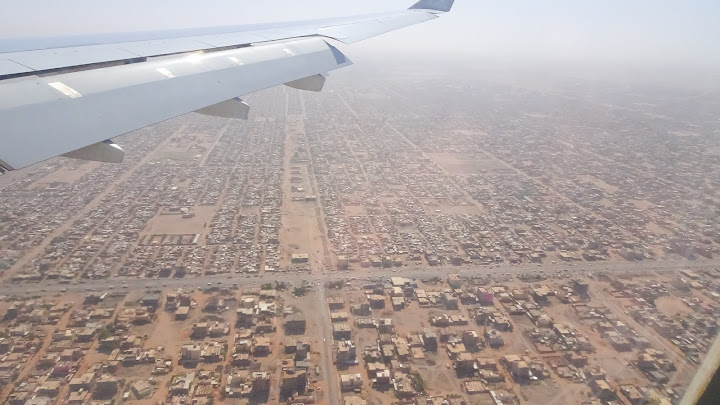
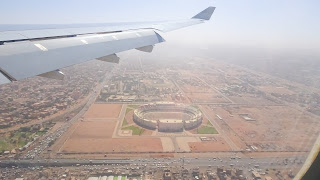



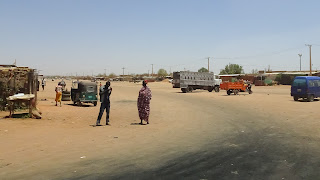

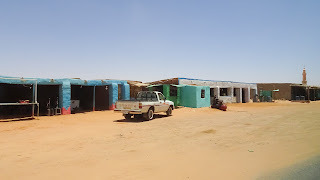

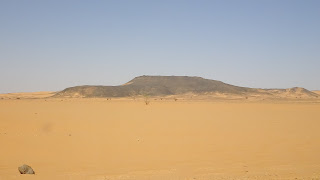



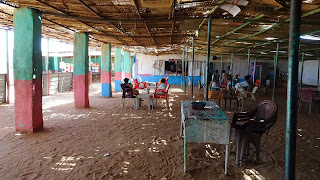











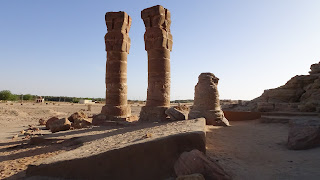










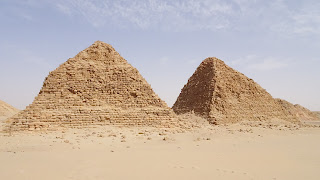




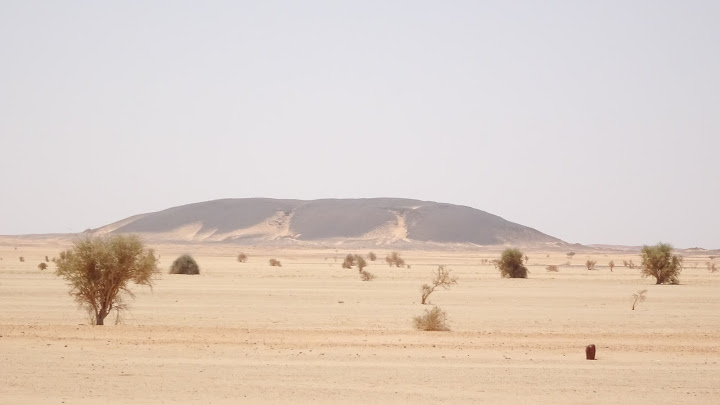



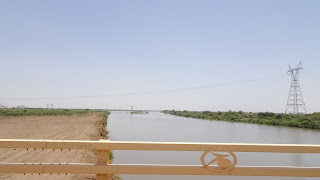







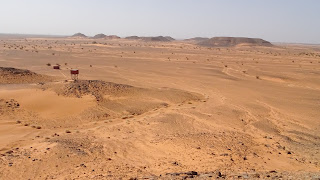


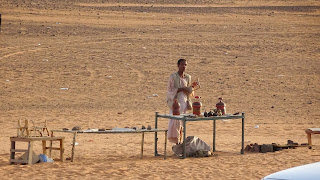



























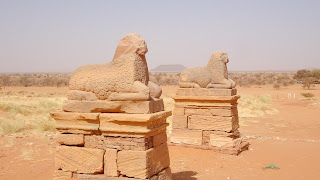














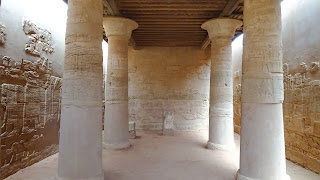




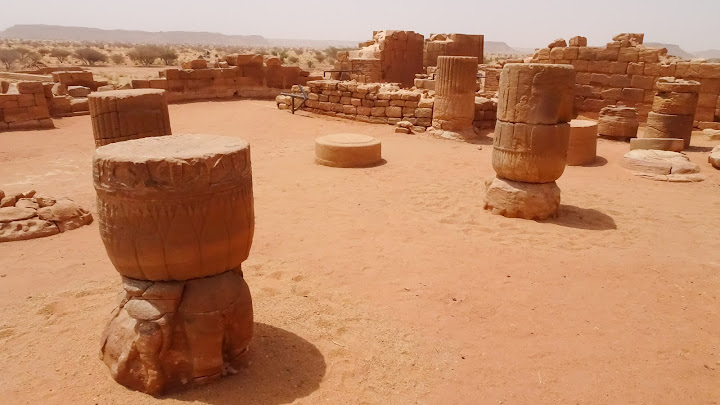










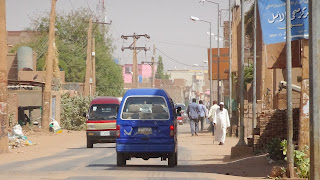


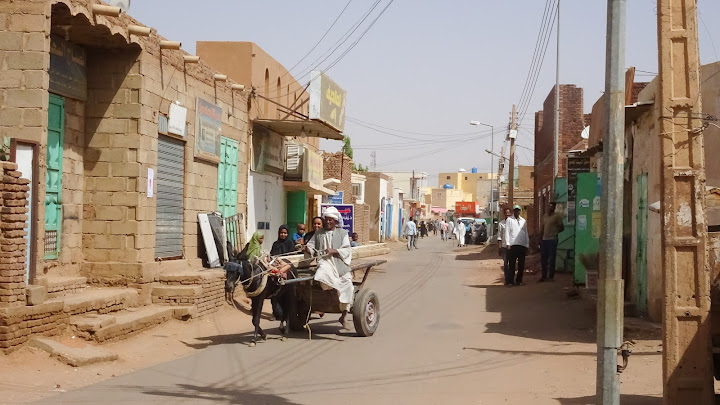

















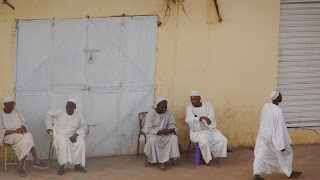





I have always wanted to visit Sudan and see all the pyramids but the heat has put me off almost entirely from it. I don’t know if it is in my blood or what but I cannot tolerate high temps outside. I get very ill from it and sometimes pass out. I ended up moving from the Florida to Canada because I wanted longer, colder winters. My family still thinks I am nuts. Anyways, I loved reading this. I live through other people’s experiences since I am not able to go to places like this myself. Great work, I can tell you are passionate about travel.
ReplyDeleteDid you do Kassala?
ReplyDeleteHi Quentin. No wasnt in Kassala. Its near to Eritrea, right? Is there something interesting to see or is your plan crossing the border to Eritrea?
Delete“All sorts of people. Some look normal, some look funny, some look like terrorists”. Really? Would you make the same comment if you saw hitchhikers in w. Europe or North America. Cmon travel is supposed to break down stereotypes not reinforce them. Sudan just got placed on Trumps banned country list because his ignorance is rooted in false stereotypes and assumptions.
ReplyDeleteThanks for reading and pointing out that Trump put Sudan on the banned country list. Im surprised to hear that, as my experience was that people are all very friendly in Sudan, no matter how they look like. In my opinion many west european countries should be put on Trumps banned country list as well, when we only look some specific hitchhikers around here.
DeleteHello from the US. Can you tell which company (travel agency) brought you around and how much it cost?
ReplyDeleteHi Trish. It was Raidan Travel http://www.raidantravel.com/
Delete